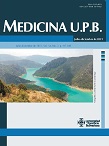Síndrome neurológico transitorio por anestésicos locales: un caso clínico con bupivacaína
Contenido principal del artículo
Resumen
Se presenta la historia de un paciente que después de realizarle anestesia espinal con bupivacaína hiperbárica 15 mg (0.5%), más fentanil 25 mcg, para prostatectomía abierta, presentó dolor en periné, lumbar y en miembros inferiores, 24 horas después de la aplicación del anestésico local. Se descarta compromiso mecánico y electromiográfico con tomografía, resonancia y electromiografía. Teniendo como diagnóstico definitivo el síndrome neurológico transitorio. En este caso la bupivacaína fue el agente causal. La duración de los síntomas por cerca de tres meses es un hallazgo novedoso en cuanto al tiempo de resolución del cuadro, Independiente de su asociación con infección del sitio operatorio.
Referencias
Schneider M, Ettlin T, Kaufmann M, Schumacher P, Urwyler A, Hampl K, et al. Transient neurologic toxicity after hyperbaric subarachnoid anesthesia with 5% lidocaine. Anesth Analg 1993; 76(5):1154–1157.
Hiller A, Karjalainen K, Balk M, Rosenberg PH. Transient neurological symptoms after spinal anaesthesia with hyperbaric 5% lidocaine or general anaesthesia. Br J Anaesth 1999; 82(4):575– 579.
Keld D, Dalgaard M, Krogh L, Rodt A. The incidence of transient neurologic symptoms (TNS) after spinal anaesthesia in patients undergoing surgery in the supine position. Hyperbaric lidocaine 5% versus hyperbaric bupivacaine 0.5%. Acta Anaesthesiol Scand 2000; 44(7):285–290.
Zaric D, Christiansen C, Pace NL, Punjasawadwong Y. Transient neurologic symptoms after spinal anesthesia with lidocaine versus other local anesthetics: A systematic review of randomized, controlled trials. Anesth Analg 2005; 100(6):1811–1816.
Zaric D, Nl P. Transient neurologic symptoms (TNS) following spinal anaesthesia with lidocaine versus other local anaesthetics (Review). The Cochrane Collaboration 2009;(2).
Ddz Z, Ccc C, Nl P, Punjasawadwong Y. Transient neurologic symptoms (TNS) following spinal anaesthesia with lidocaine versus other local anaesthetics (Review). The Cochrane Collaboration 2009;(1).
Salazar F, Bogdanovich A, Adalia R, Chabas E, Gomar C. Transient neurologic symptoms after spinal anaesthesia using isobaric 2% mepivacaine and isobaric 2% lidocaine. Acta Anaesthesiol Scand 2001; 45(2):240–245.
Philip J, Sharma SK, Gottumukkala VN, Perez BJ, Slaymaker E, Wiley J. Transient neurologic symptoms after spinal anesthesia with lidocaine in obstetric patients. Anesth Analg 2001; 92(2):405–409.
Aguilar JL, Pelaez R. Transient neurological syndrome: Does it really exist? Curr Opin Anaesthesiol 2004; 17(5):423–426.
Beardsley D, Holman S, Gantt R, Robinson R, Lindsey J, Bazaral M, et al. Transient neurologic deficit after spinal anesthesia: Local anesthetic maldistribution with pencil point needles? Anesth Analg 1995; 81(2):314–320.
Pollock JE, Liu SS, Neal JM, Stephenson C. Dilution of spinal lidocaine does not alter the incidence of transient neurologic symptoms. Anesthesiology 1999; 90(2):445–450.
Cramer BG, Stienstra R, Dahan A, Arbous MS, Veering BT, Van Kleef JW. Transient neurological symptoms with subarachnoid lidocaine: Effect of early mobilization. Eur J Anaesthesiol 2005; 22(1):35–39.
Farid I, Hernandez-Popp V, Youssef GN, Mekhail N. Bupivacaine induces transient neurological symptoms after subarachnoid block. Pain Practice 2002; 2(1):53–55.
Myer R, Klichman M, Reisner L, Powell H. Neurotoxicity of local anesthetics: Altered perineural permeability, edema, and nerve fiber injury. Anesthesiology 1986; 64(1):29–35.
Sakura S, Bollen a W, Ciriales R, Drasner K. Local anesthetic neurotoxicity does not result from blockade of voltage-gated sodium channels. Anesth Analg 1995; 81(2):338–346.
Wang BC, Hillman DE, Spielholz NI, Turndorf H. Chronic neurological deficits and NesacaineCE-an effect of the anesthetic, 2-chloroprocaine, or the antioxidant, sodium bisulfite? Anesth Analg 1984; 63(4):445–447.
Kanai Y, Katsuki H, Takasaki M. Lidocaine disrupts axonal membrane of rat sciatic nerve in vitro. Anesth Analg 2000; 91(4):944–948.


